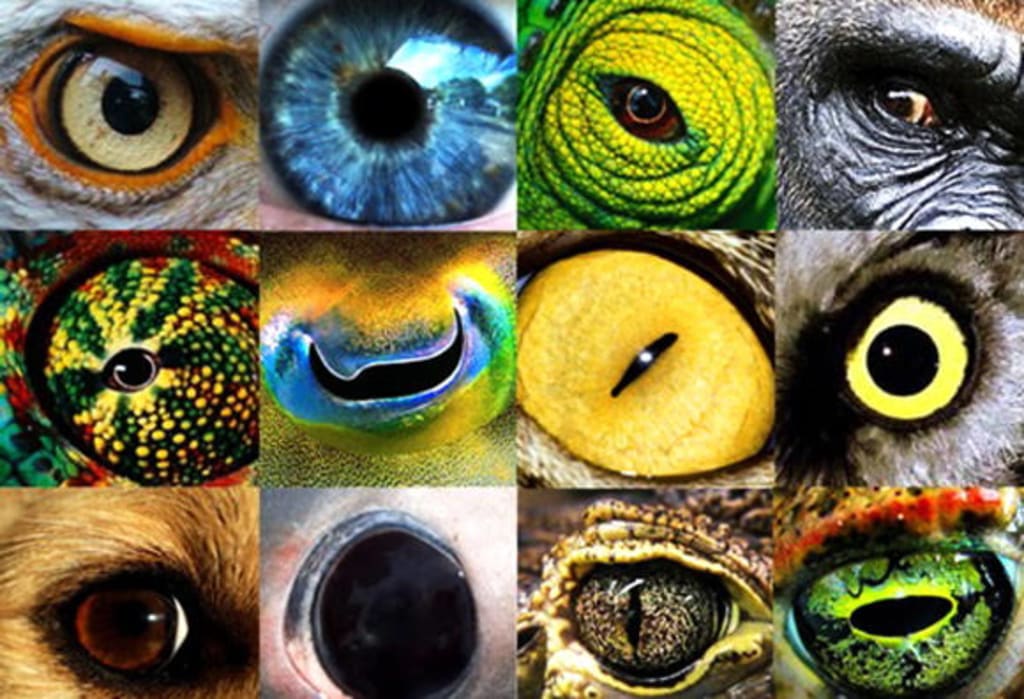The World Through the Eyes of Animals
A Journey Through the Unique Visual Realms of Creatures, from Snakes' Infrared Vision to Chameleons' 360-Degree Gaze

Animals perceive the world through a vast array of sensory experiences, ones that often differ significantly from our own human perspective. A captivating journey into the animal kingdom reveals fascinating insights into their diverse visual perceptions.
Consider pigeons, for instance, which boast surprisingly superior vision to humans. Isn't that a remarkable revelation? Let's embark on this enlightening expedition to perceive the world as various creatures do. Our first stop is the serpentine realm. Snakes possess a unique vision, relying on specialized infrared-sensitive receptors in their snouts. These receptors detect radiated heat from warm-blooded mammals, creating a distinctive vision unlike our own.
Now, shift your gaze to the bovine inhabitants. Cows, impressive in size, perceive colors differently from humans. Lacking the essential receptors for red hues in their retinas, they navigate a world painted in shades of blue and green. Remarkably, cows possess near-panoramic vision, with their only blind spot being directly behind them. A gentle approach is advisable to avoid startling these gentle giants.
Venture onwards to the realm of equines. Horses exhibit a curious blind spot right before their noses, courtesy of their unique eye placement. Consequently, they miss objects situated directly in front of them. Furthermore, their visual spectrum is limited, primarily comprising shades of green, yellow, and blue. These animals' world unfolds in these muted yet vivid tones.
The aquatic domain introduces us to the mesmerizing gaze of fish. With ultraviolet receptors and spherical lenses, their vision spans nearly 360 degrees. Despite sharing our color perception, their underwater environment alters light behavior, posing challenges in distinguishing red shades. In the depths, however, deep-sea fish master the art of seeing in the darkness, an ability that indeed astounds.
Sharks, despite their menacing reputation, lack the ability to differentiate colors. Nevertheless, they exhibit remarkable clarity underwater, a phenomenon that leaves us in awe. Birds, on the other hand, boast a visual spectrum beyond human reach. They perceive ultraviolet light, a crucial tool for identifying mates and navigating their surroundings. Falcons and eagles showcase exceptional focusing skills, honed to spot prey from great distances.
A remarkable avian ambassador, the pigeon, takes center stage. With an extraordinary 340-degree field of vision, pigeons possess vision twice as acute as humans'. Their keen eyesight can discern intricate details, making them unlikely urban navigators. Insects, too, boast exceptional visual adaptations. Flies, with their numerous eye receptors, process a comprehensive view of their surroundings in slow motion. They also detect ultraviolet light, enhancing their perception of the world.
Bees, despite their important pollination role, grapple with their own visual limitations. The color red appears to them as dark blue, an intriguing distortion of the spectrum. Rodents, like rats, share a similar quirk; red remains outside their visual spectrum. Adding to their peculiarity, each of their eyes functions independently, often resulting in a dual visual experience.
Cats, with their enigmatic charm, perceive the world through a unique lens. They lack the ability to distinguish shades of red and green. However, their vision excels in detecting brown, yellow, and blue hues. Boasting a wide-angle view, cats are adept at observing their surroundings from various angles. Under the cover of darkness, feline prowess comes to light. Their night vision is six times superior to ours, adjusting effortlessly to the ambient light.
Man's best friend, the dog, possesses a vibrant visual palette. They struggle with red and orange hues but excel in distinguishing shades of blue and violet. Impressively, dogs can discern an impressive 40 shades of gray, highlighting their intricate visual acumen. Amphibian inhabitants, such as frogs, exhibit selective visual appetites. Food must be in motion to catch their attention; otherwise, it goes unnoticed. Shadows and non-essential elements are relegated to insignificance in their sight.
Enter the domain of the chameleon, showcasing unparalleled visual capabilities. With independent eye movement, these creatures can observe their surroundings without turning their heads. This remarkable trait enables them to view two images concurrently—one in front and the other behind—an astonishing feat that sets them apart.
As we conclude our extraordinary expedition into the visual worlds of animals, ponder a thought: What if you were bestowed with 360-degree vision like a chameleon? Share your musings in the comments. If this exploration quenched your curiosity, a like and share would be greatly appreciated.
Watch video on YouTube @BRIGHTSIDE






Comments
There are no comments for this story
Be the first to respond and start the conversation.